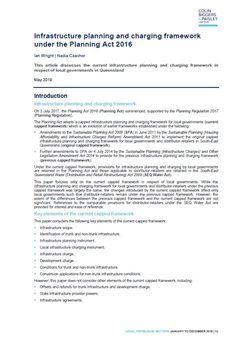Introduction
Infrastructure planning and charging framework
On 3 July 2017, the Planning Act 2016 (Planning Act) commenced, supported by the Planning Regulation 2017 (Planning Regulation).
The Planning Act adopts a capped infrastructure planning and charging framework for local governments (current capped framework) which is an evolution of earlier frameworks established under the following:
-
Amendments to the Sustainable Planning Act 2009 (SPA) in June 2011 by the Sustainable Planning (Housing Affordability and Infrastructure Charges Reform) Amendment Act 2011 to implement the original capped infrastructure planning and charging framework for local governments and distributor-retailers in South-East Queensland (original capped framework).
-
Further amendments to SPA on 4 July 2014 by the Sustainable Planning (Infrastructure Charges) and Other Legislation Amendment Act 2014 to provide for the previous infrastructure planning and charging framework (previous capped framework).
Under the current capped framework, provisions for infrastructure planning and charging by local governments are retained in the Planning Act and those applicable to distributor-retailers are retained in the South-East Queensland Water (Distribution and Retail Restructuring) Act 2009 (SEQ Water Act).
This paper focuses only on the current capped framework in respect of local governments. While the infrastructure planning and charging framework for local governments and distributor-retailers under the previous capped framework was largely the same, the changes introduced by the current capped framework affect only local governments such that distributor-retailers remain under the previous capped framework. However, the extent of the differences between the previous capped framework and the current capped framework are not significant. References to the comparable provisions for distributor-retailers under the SEQ Water Act are provided for interest and ease of reference.
Key elements of the current capped framework
This paper considers the following key elements of the current capped framework:
-
Infrastructure scope.
-
Identification of trunk and non-trunk infrastructure.
-
Infrastructure planning instrument.
-
Local infrastructure charging instrument.
-
Infrastructure charge.
-
Development charge.
-
Conditions for trunk and non-trunk infrastructure.
-
Conversion applications for non-trunk infrastructure conditions.
However, this paper does not consider other elements of the current capped framework, including:
To read the full article, click here.

This is commentary published by Colin Biggers & Paisley for general information purposes only. This should not be relied on as specific advice. You should seek your own legal and other advice for any question, or for any specific situation or proposal, before making any final decision. The content also is subject to change. A person listed may not be admitted as a lawyer in all States and Territories. © Colin Biggers & Paisley, Australia 2024.